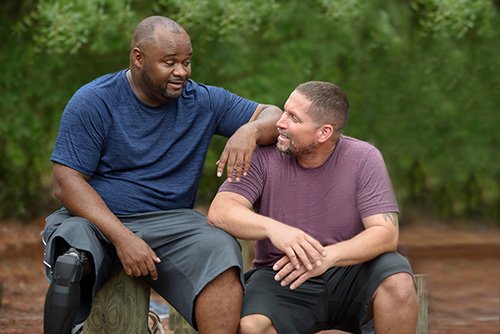5 Things to Know About Veterans and CTE

It’s not uncommon for military veterans to experience head-related trauma during their service career. The Traumatic Brain Injury Center of Excellence reports that more than 485,000 service members sustained a traumatic brain injury (TBI) from 2000 to 2023 — ranging from mild concussions to more severe head injuries. Still, most people may not be aware of a link between TBIs and a disease known as Chronic Traumatic Encephalopathy (CTE).
1. What is CTE?
CTE is a form of TBI caused by a buildup of tau proteins in the brain. Tau is usually a helpful protein, ensuring cells talk to each other. But in the aftermath of repeated falls, concussions, or other head trauma, the protein becomes jumbled. It can affect mood, cognition, and behavior. Over time, day-to-day things that were once routine become challenging.
2. What are the main symptoms of CTE?
Depending upon the severity and location of the brain injury, symptoms linked to CTE can vary and may occur years or decades after head trauma. The most common signs may include:
-
Cognitive: Memory problems, confusion, difficulty thinking, impaired judgment.
-
Mood: Depression, anxiety, irritability, aggression.
-
Behavioral: Impulsivity, violence, suicidality.
-
Physical: Headaches, dizziness, tremors, difficulty balancing.
3. Who is at risk for CTE?
People with a history of repeated head injuries have an increased risk of developing CTE, including athletes in high-impact sports and service members in combat. Researchers have also found CTE in people who suffered head injuries as a result of car accidents or domestic violence. However, not everyone who has had head injuries will develop CTE. The risk appears to increase with the number and severity of injuries.
4. How is CTE diagnosed?
CTE can only be definitively diagnosed after death during an autopsy of the brain. While research is underway to find a test to diagnose people while living, doctors can make a probable diagnosis by reviewing symptoms and risk factors and conducting specific neurologic imaging and cognitive function tests.
5. How do you treat CTE?
Although there is currently no cure for CTE, medication, cognitive therapy, and lifestyle changes are the most common therapies helping people suspected to have CTE live a better quality of life. Research is ongoing to identify potential new treatments.
To minimize veterans’ risk of developing CTE, it is critical to avoid repeated head trauma. But it is also necessary to raise awareness in the warrior community about the link between head injuries and CTE and ensure access to appropriate rehabilitation and care.
Wounded Warrior Project® (WWP) addresses head trauma through several programs and services.
-
Independence Program helps warriors and families living with moderate to severe TBI overcome obstacles and exceed goals.
-
Warrior Care Network® is a partnership with four of the nation’s top facilities for trauma recovery, providing veterans with mental health and brain injury care. Treatment at Warrior Care Network is proven to be faster and more effective than traditional treatments.
Contact: Cynthia Weiss – Public Relations, cweiss@woundedwarriorproject.org, 904.738.2589
About Wounded Warrior Project
Since 2003, Wounded Warrior Project® (WWP) has been meeting the growing needs of warriors, their families, and caregivers — helping them achieve their highest ambition. Learn more.